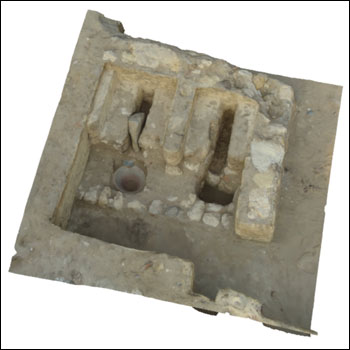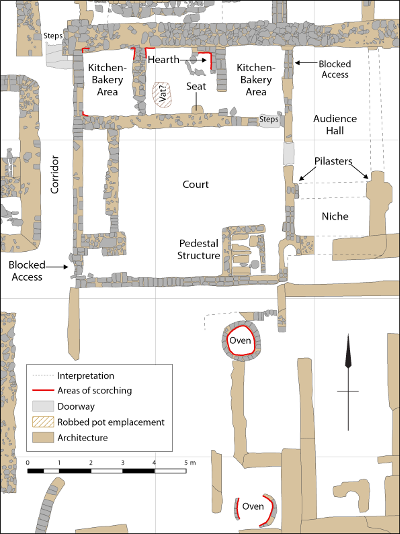
This pedestal, found tucked in a closet in the courtyard of the AA-S house, is the best preserved example we have found to date. 3D image created by Kirk Roberts
Ever since we uncovered the first pedestals on the Heit el-Ghurab (Lost City of the Pyramid Workers) site, we have puzzled over their function. The first pedestals were found in 1988 in what came to be known as the Pedestal Building and had tops that were completely eroded and revealed little about their purpose. Eventually we concluded that they probably supported some sort of storage device, such as a bin that straddled the space between two pedestals.
Since that initial discovery, we’ve found many more pedestals in various configurations: both large groups & small sets, in closets & out in the open, isolated & aligned in rows in institutional structures — but always with a gap, or slot, between pedestals.
One big clue to the pedestals function came in the 2006-2007 seasons when we discovered a row of pedestals at the southern end of the Pedestal Building with low mud partitions on top that appeared to define where bins may have rested. In front of some of the slots between the pedestals we found beer jars propped upright at the gaps, as if positioned to catch drips from whatever was stored above or perhaps to serve as standard measures for doling out the contents.
Another clue to the function of the pedestals comes from the many “peg and string” sealings discovered in the vicinity of the Pedestal Building. These sealings could derive from opening and closing the peg and string locks on the chests that may have straddled two adjacent pedestals.

The AA-S area showing the location of the pedestal structure, depicted above.
Then, in 2015, we discovered the best preserved example of a pedestal to date in the AA-S area, just south of the Pedestal Building, which has provided even more tantalizing clues. This entire pedestal structure was meticulously maintained with repeated repairs to the thick plaster. This layout assured that no one standing outside the pedestal closet could see the pedestals or observe whatever might be withdrawn from containers on them, especially if the walls were full height. This emphasis on cleanliness and privacy suggests that the stored goods were best kept in a clean, dry environment and perhaps needed to be secured or hidden from view.
In AA-S we also discovered that a variety of goods were stored above the pedestals, which required different types of containers to hold their contents below. Here, instead of jars, we found a large bowl and a hole that probably once held another bowl in front of the slots. These bowls may have supported baskets or skin bags, which could be filled with dry commodities or liquids stored above that drained into them, allowing a worker to ladle the substance into another vessel. This is in contrast to two other damaged pedestals we also found in 2015 in the building just to the west, where we again found jars positioned at the slots.
We’ve documented the well-preserved AA-S pedestal by using photogrammetery to create a 3D image of the entire pedestal structure. You can download an interactive 3D PDF of this image which will allow you to zoom in and rotate the image and see for yourself how it may have functioned.
Download a 3D PDF of the AA-S pedestal here.
If you browser cannot display the 3D PDF, try downloading the PDF & opening it directly in Adobe PDF Reader.
More information on the Heit el-Ghurab pedestals has been published in our newsletter:
AERAGRAM Vol. 16, no. 2: “Official’s House Emerges in Season 2015” (currently only available to AERA members)
AERAGRAM Vol. 15, no. 1/2: “A Return to Area AA: Informal Seals and Sealings of the Heit el-Ghurab”
AERAGRAM Vol. 8, no. 2: “Enigma of the Pedestals: 2006-2007 Season”
